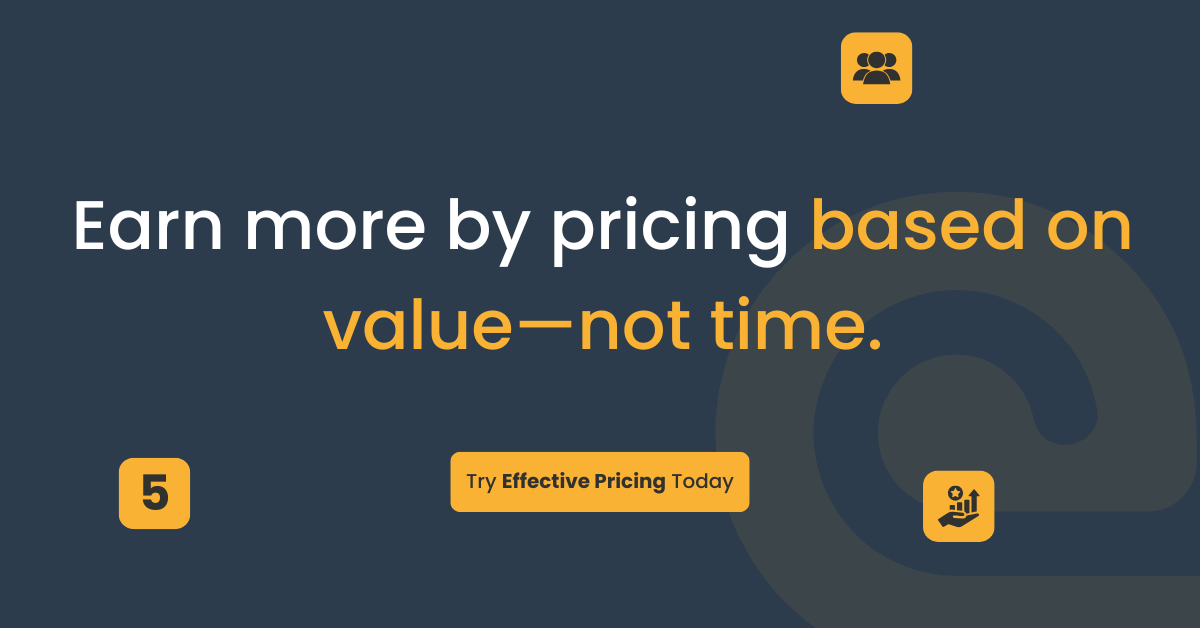5 Key Value Pricing Principles for Accounting and Bookkeeping Services
Pricing is one of the biggest challenges for accountants and bookkeepers. Many firms still rely on hourly billing, which often leads to frustration, undervaluing services, and pricing pushback from clients. Value pricing provides a better way to set prices that align with the value you deliver rather than the time you spend.
In this blog, we’ll cover the five key value pricing principles that will help you achieve better prices for your accounting and bookkeeping services.
1. Move Away from Time-Based Billing

One of the biggest shifts you need to make is moving away from time-based billing. There are only two ways to price services:
- Cost-Plus Pricing – This method calculates the cost of delivering a service, adds a profit margin, and sets a price. Time-based billing falls into this category, as hourly rates are set based on firm costs and desired profit.
- Value Pricing – This approach focuses on pricing services based on the value they deliver to clients, not the cost of delivering them. The customer’s perception of value dictates the price.
Cost-plus pricing ignores the client’s needs, while value pricing puts them at the centre of the pricing decision.
Why Time-Based Billing Doesn't Work
- Clients dislike it – A Sage study from 2005 found that the number one thing business owners dislike about accountants is surprise bills. Time-based billing prevents clients from knowing the final cost upfront, which creates uncertainty and dissatisfaction.
- It limits your income – If you charge by the hour, the only way to earn more is to work longer hours or increase your hourly rate. This caps your earnings and can lead to burnout.
- It ignores efficiency – The more experienced and efficient you become, the faster you complete work. With hourly billing, working faster means earning less. With value pricing, expertise and efficiency are rewarded.
Switching to value pricing allows firms to set prices based on the value provided rather than the time spent, making services more predictable and profitable.
2. Recognise That Clients Will Pay More for Value

Many accountants hesitate to increase prices because they assume their clients are price-sensitive. The reality is that most clients are value-sensitive, meaning they consider the value they receive before making a buying decision.
Understanding Value Sensitivity
- Price-sensitive clients always choose the cheapest option, regardless of value.
- Value-sensitive clients compare the cost with the benefits and are willing to pay more for better quality or service.
Most business owners fall into the value-sensitive category. If you offer valuable services and communicate them well, clients will pay higher prices.
For example:
- Clients who purchase Apple products value quality, branding, and the user experience.
- Clients who buy coffee from Starbucks instead of the cheapest alternative value convenience, experience, and taste.
Your clients make similar decisions with accounting services. If they see the value in your offering, they’ll pay a fair price.
3. Understand the Value Pricing Journey
Transitioning from time-based billing to value pricing doesn’t happen overnight. It’s a journey, and the first step is often moving from hourly billing to fixed pricing.
The Pricing Journey
- Fixed Pricing – Instead of billing by the hour, provide a set price for a service before starting the work. While fixed pricing is still cost-plus pricing, it eliminates surprises for clients and allows for better profit margins.
- Menu Pricing – The next step is offering multiple pricing tiers (e.g., Bronze, Silver, Gold) so clients can choose the level of service that fits their needs.
- Value Pricing – Finally, shift towards pricing based on the perceived value to the client rather than the cost or time involved in delivering the service.
4. Use Menu Pricing to Give Clients a Choice

A powerful technique in value pricing is menu pricing, where you offer different service levels (e.g., Bronze, Silver, Gold).
Why Menu Pricing Works
- Clients love choice – When given multiple options, clients can select the package that best fits their needs and budget.
- Higher revenue potential – Some clients want premium services and are willing to pay more. Without an upgraded option, they can’t choose to pay a higher price.
- Better pricing psychology – Most people pick the middle option, making it easier to position higher-value services.
Successful companies like Apple use this strategy. When purchasing a MacBook, clients see multiple configurations at different price points, making them more likely to upgrade. Accounting firms can use the same principle to increase revenue while serving clients at different levels.
5. Reprice Existing Clients for Better Profits
Many firms focus on pricing new clients correctly but forget to reprice existing clients. If you’re currently undercharging, repricing existing clients is the fastest way to improve profitability.
How to Reprice Clients Successfully
- Communicate added value – Explain what has changed in your service offering and how clients will benefit.
- Provide options – Offer different pricing tiers so clients can select the best fit.
- Start with new clients – Implement value pricing for new clients first, then gradually adjust existing ones.
Firms that follow a structured repricing strategy often increase average fees by 20–40% without losing clients. This improvement can double profits without taking on more work.
Implement Value Pricing in Your Firm

Shifting from time-based billing to value pricing leads to better pricing, stronger client relationships, and increased profitability. By applying these five principles, you can achieve higher prices and build a more sustainable firm:
- Move away from hourly billing – Price based on value, not time.
- Recognise that clients will pay more for value – Focus on delivering and communicating value.
- Follow the value pricing journey – Start with fixed pricing, then move to menu and value pricing.
- Use menu pricing – Offer different packages to increase revenue and appeal to different client needs.
- Reprice existing clients – Improve profitability by adjusting fees for current clients.
Try Effective Pricing
Confidently set prices that reflect the true value of your services. Try Effective Pricing and take control of your firm’s profitability.
Value pricing ensures that your fees align with the benefits you deliver to clients. Apply these principles today to make pricing more strategic and effective.





